p.163
p.173
p.179
p.184
p.190
p.196
p.202
p.208
p.214
The Effect of Filler Content on the Mechanical Properties of Polymer Composite
Abstract:
A composite material is a macroscopic combination of two or more distinct materials, having a recognizable interface between them. Modern composite materials are usually optimized to achieve a particular balance of properties for a given range of applications. Composites are commonly classified at two distinct levels. The first level of classification is usually made with respect to the matrix constituent. The major composite classes include organic – matrix composites (OMC's), metal – matrix composites (MMC's), and ceramic – matrix composites (CMC's). The OMC's is generally assumed to include two classes of composites: polymer – matrix composites (PMC's) and carbon – matrix composites [1]. The composite material used in the work belongs to the PMC's and the composite is formed by the polymer matrix - high density polyethylene. As filler was used hard-magnetic strontium ferrite. Composite samples were prepared with different filler content (0%, 60%, 70%, 80%). Testing of polymer composites included: tensile test, elongation at break, impact test, hardness test.
Info:
Periodical:
Pages:
190-195
Citation:
Online since:
November 2016
Authors:
Keywords:
Price:
Сopyright:
© 2017 Trans Tech Publications Ltd. All Rights Reserved
Share:
Citation:


